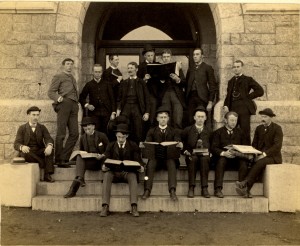“the spirit of Haverford’s culture has not been a narrow one, nor could it be…”
—John Greenleaf Whittier
When we consider students’ relationship to a tightly crafted curriculum like the one of Haverford in the early 19th century, we imagine students as recipients of texts. Curiosity about communities of readers and scholarship often lead us to explore the texts themselves, especially if they remain in the archives. When we are fortunate enough to discover marginalia in these texts, we can begin to interpret students’ relationships to their scholarship and to each other. As a result, we locate the space of the student voice in the margin—physically and metaphorically.
Yet as historian Roger Chartier reminds us in The Order of Books, when we study the history of readership it is crucial to “also keep in mind that reading is always a practice embodied in acts, spaces, and habits.” It is in considering these acts, spaces, and habits that we hone our understanding of the relationships of power, agency, and collaboration that such histories of readership elucidate.
This exhibit explores the ways in which archival documents from many of the practices of early Haverford students provide a robust sense of embodiment that carries students’ voices beyond the margin and into rich dialogue with the Quaker foundations that shape its reading practices. From participation in literary societies to a co-curricular engagement in a book cremation ceremony, students’ early reading practices demonstrate the scholarly acumen, creative spirit, and engagement with institutional power that are deeply rooted in Haverford.



